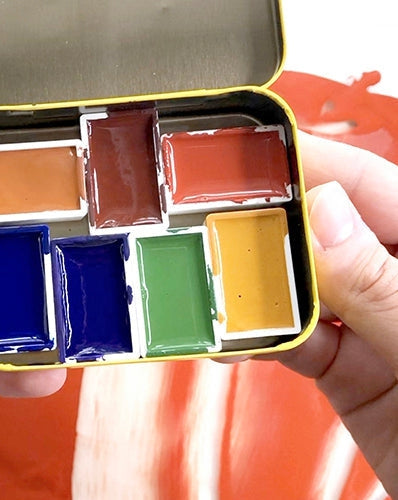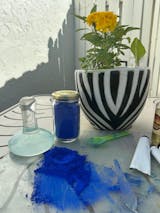Making your own watercolors allows you to make an incredibly archival, high quality paint that has a more brilliant luminosity than tubed pro-quality watercolors and is free of fillers, preservatives, heavy metals, petroleum-based pigments and toxins.
And it couldn't be simpler!

Ingredients
or
- Earth & Mineral Pigments
- Gum Arabic Powder
- Honey (if you want a vegan version, use glycerin)
Optional Ingredients:
- Clove or thyme essential oil (preservative)
- Sodium benzoate (stronger preservative)
- Oxgal (increases flow, not vegan)

1. Prepare Watercolor Medium:
6 Tbsp hot water
3 Tbsp gum arabic powder
2 Tbsp honey
1. Pour gum arabic powder into the hot water and mix until fully dissolved
2. Mix in honey
3. Optional- add 1-2 drops clove or thyme essential oil or 1/2 teaspoon of sodium benzoate as a preservative and mix thoroughly
Notes: Watercolor medium must be stored in an airtight container in the refrigerator until used (will last up to 1 year).
This recipe makes enough medium for 20-25 full pans

2. Prepare Watercolor Paint
Mix 1 part watercolor medium with 1 part pigment (adjust as necessary). For example, if you're using 1 Tbsp. of the watercolor base, use 1 Tbsp. pigment.
Note: Each natural pigment has different properties and behaves differently, so you will need to adjust pigment amount accordingly. For example, we find that Ultramarine Blue needs a little more pigment than 1:1, and Terre Verte needs less pigment.

Scoop pigment onto glass palette and make a small indentation on top.
Pour medium onto pigment (or use a glass dropper) and mix with a palette knife on a glass palette. If the texture feels a little gritty, add a drop or two of more medium and keep mixing.

Optional: For more thorough mixing, mix the pigment and the mixture with a glass muller by making circular motions over the paint, then using the palette knife to scrape the paint back into a pile and mulling again. See more notes on mulling at the end of this post.

3. Storing
Scoop and scrape the paint into your chosen container with the palette knife. Store in airtight jars or small aluminum tubes, or let dry into cakes or pans. If drying into cakes or pans, let dry thoroughly - ideally 3 days to a week - in a warm, dry place out of direct sunlight. For best results, fill pan 1/2 way, let dry 1 or 2 days, then fill to the top and let dry.
To fill 1 full pan, start with 1 teaspoon watercolor medium and 1 teaspoon pigment.

Notes
- If you are storing the watercolor base for an extended period, refrigerate to extend shelf life (up to 1 year). These preservative options are natural and mild so they will not preserve the paints at hot or room temperatures for long periods of time like toxic, synthetic preservatives do.
Artist Tips
- Add 2 drops of oxgall to increase flow of paint. Add 24 drops of glycerine to increase flow and add more vibrancy.
- If the cakes crack when dry, make a note of which color and add more of the Gum Arabic solution next time. Alternatively, adding a few drops of glycerin helps as well.
More of a visual learner? Check out our Vibrant Earth Watercolor tutorial!
About Mulling:
-Don't press down hard, just us an even pressure of your arm's natural weight
-Move the paint around in circles or figure eight movements
-Listen for the change in sound as you move the muller, when it's getting closer to ready you'll notice it becomes quieter and has a smooth sound rather than a raspy or uneven noise.
-Lift the muller away and use the palette knife to scrape the paint back into a pile. Keep mulling until all feels easy and smooth. It might be 5 minutes, or it might be 20.
About the Ingredients:
Honey:
Honey is a humectant which helps the paint retain moisture and re-wet after drying. Honey is also a natural preservative and a plasticiser, meaning that it increases the flexibility of gum Arabic (a naturally brittle binder) and prevent cracking in the pan after drying. Runny honey is best, rather than the harder variety.
Gum Arabic is a water-soluble gum which is extracted from the acacia tree, and it acts as the glue that binds the pigment.
Glycerin:
Like honey, glycerin is a humectant and a plasticiser which can be bought at a pharmacy (it is a common ingredient in skincare products). I use both honey and glycerin in my binder because I find too much honey to be very sticky, but either glycerin or honey would work on its own.
Clove Oil:
A natural antibacterial and antifungal agent, clove oil is an excellent preservative which stops the paint going moldy.
Interested in more recipes featuring Natural Earth Paint products? Visit our Recipes page!
Follow us on Instagram, Facebook, and Pinterest for more natural inspiration.





